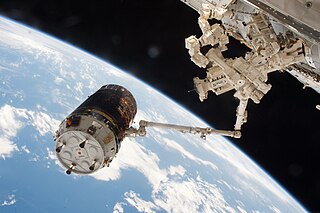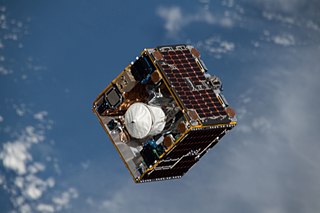
A CubeSat is a class of miniaturized satellite based around a form factor consisting of 10 cm (3.9 in) cubes. CubeSats have a mass of no more than 2 kg (4.4 lb) per unit, and often use commercial off-the-shelf (COTS) components for their electronics and structure. CubeSats are put into orbit by deployers on the International Space Station, or launched as secondary payloads on a launch vehicle. As of August 2021, more than 1,600 CubeSats have been launched.
CUTE-1.7 + APD or CO-56 (Cubesat-Oscar-56) or just OSCAR 56 was an amateur radio satellite in the form of a double CubeSat. The satellite used commercial off-the-shelf components extensively, in particular, it used the Hitachi NPD-20JWL PDA as a control computer, and it used a USB hub for sensor communications. At the end of its mission, the satellite was supposed to deploy an electrodynamic tether to help it deorbit. The satellite failed early into its mission, so the electrodynamic tether experiment probably did not happen. It was launched on February 21, 2006 on board a Japanese launcher M-V.
The Multi-Application Survivable Tether (MAST) experiment was an in-space investigation designed to use CubeSat spacecraft connected by tethers to better understand the survivability of tethers in space. It was launched as a secondary payload on a Dnepr rocket on 17 April 2007 into a 98°, 647 x 782 km orbit. The MAST payload incorporated three picosatellites, named "Ralph," "Ted," and "Gadget," which were intended to separate and deploy a 1 km (0.62 mi) tether. The experiment hardware was designed under a NASA Small Business Technology Transfer (STTR) collaboration between Tethers Unlimited, Inc. (TUI) and Stanford University, with TUI developing the tether, tether deployer, tether inspection subsystem, satellite avionics, and software, and Stanford students developing the satellite structures and assisting with the avionics design.

Kagawa University is a national university in Takamatsu, Kagawa, Japan. The university was established in 1949 as a national university after the consolidation and reorganization of the Kagawa Normal School, the Kagawa Normal School for Youth and the Takamatsu College of Economics.
AeroCube-3 is a single-unit CubeSat which was built and is being operated by The Aerospace Corporation, at El Segundo, California. It is the third AeroCube picosatellite, following on from AeroCube-1, which was lost in a launch failure in 2006, and AeroCube-2 which was successfully launched in 2007 but failed immediately after launch. Compared to its predecessors it contains several improvements in its infrastructure, including a redesigned power system, replacing the older system which was responsible for the loss of AeroCube-2. Its development was funded by the United States Air Force Space and Missile Systems Center, at Los Angeles Air Force Base.
CP6, also known as CP6 CubeSat, CalPoly CP-6, PolySat-6 or PolySat CP6 is a single-unit CubeSat which was built and operated by the California Polytechnic State University (CalPoly). It was primarily intended to perform a technology demonstration mission. The main experiment consisted of sensors to determine the spacecraft's attitude. Cameras on the satellite will be used to verify the data returned by the attitude sensors.

NanoSail-D2 was a small satellite built by NASA's Marshall Space Flight Center and Ames Research Center to study the deployment of a solar sail in space. It was a three-unit CubeSat, measuring 30 cm × 10 cm × 10 cm with a mass of 4 kg (8.8 lb). Its solar sail had an area of 10 m2 (110 sq ft), and was deployed in around five seconds.

A number of space tethers have been deployed in space missions. Tether satellites can be used for various purposes including research into tether propulsion, tidal stabilisation and orbital plasma dynamics.

Space tethers are long cables which can be used for propulsion, momentum exchange, stabilization and attitude control, or maintaining the relative positions of the components of a large dispersed satellite/spacecraft sensor system. Depending on the mission objectives and altitude, spaceflight using this form of spacecraft propulsion is theorized to be significantly less expensive than spaceflight using rocket engines.
Technology Education Satellite (TechEdSat) is a successful nano-sat flight series conducted from the NASA Ames Research Center in collaboration with numerous universities. While one of the principal aims has been to introduce young professionals and university students to the practical realm of developing space flight hardware, considerable innovations have been introduced. In addition, this evolving flight platform has tested concepts for Low Earth Orbit (LEO) sample return, as well as planetary nano-sat class mission concepts.

ESTCube-1 is the first Estonian satellite and first satellite in the world to attempt to use an electric solar wind sail (E-sail). It was launched on 7 May 2013 aboard Vega VV02 carrier rocket and successfully deployed into orbit. The CubeSat standard for nanosatellites was followed during the engineering of ESTCube-1, resulting in a 10×10×11.35 cm cube, with a volume of 1 liter and a mass of 1.048 kg.

Nanoracks LLC is a private in-space services company which builds space hardware and in-space repurposing tools. The company also facilitates experiments and launches of CubeSats to Low Earth Orbit.
iCube-1 is a miniaturised satellite built by the Institute of Space Technology in Pakistan, with an objective to provide a wide range of future experiments in the domain of imaging, microgravity, biology, nanotechnology, space dynamics, chemistry, space physics and various other fields. It can also provide a testbed for developing satellite constellations for specific applications.

Kounotori 6 (こうのとり6号機), also known as HTV-6, was the sixth flight of the H-II Transfer Vehicle, an uncrewed cargo spacecraft launched to resupply the International Space Station. It was launched at 13:26:47 UTC on 9 December 2016 aboard H-IIB launch vehicle from Tanegashima Space Center.

Mars Cube One was a Mars flyby mission launched on 5 May 2018 alongside NASA's InSight Mars lander. It consisted of two nanospacecraft, MarCO-A and MarCO-B, that provided real-time communications to Earth for InSight during its entry, descent, and landing (EDL) on 26 November 2018 - when InSight was out of line of sight from the Earth. Both spacecraft were 6U CubeSats designed to test miniaturized communications and navigation technologies. These were the first CubeSats to operate beyond Earth orbit, and aside from telecommunications they also tested CubeSats' endurance in deep space. On 5 February 2019, NASA reported that both the CubeSats had gone silent by 5 January 2019, and are unlikely to be heard from again. In August 2019, the CubeSats were honored for their role in the successful landing of the InSight lander on Mars.

RemoveDEBRIS was a satellite research project intending to demonstrate various space debris removal technologies. The mission was led by the Surrey Space Centre from the University of Surrey with the satellite's platform manufactured by Surrey Satellite Technology Ltd (SSTL). Partners on the project included Airbus, ArianeGroup, Swiss Center for Electronics and Microtechnology, Inria, Innovative Solutions In Space, Surrey Space Centre, and Stellenbosch University.

RSat-P is a microsatellite built by the United States Naval Academy (USNA) in Annapolis, Maryland. The small spacecraft is a 3U CubeSat intended to demonstrate capabilities for minor in-orbit repair of a much larger, conventional spacecraft.
STARS-EC was a nanosatellite developed by Shizuoka University, for the purpose of demonstrating space elevator tether technology. It was a 3U-size CubeSat, and could split into three separate satellites, connected via tethers. STARS-EC was launched on 20 February 2021, and was deployed from the International Space Station (ISS). The deployment service of STARS-EC was provided by Mitsui Bussan Aerospace.










